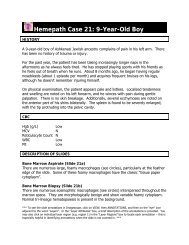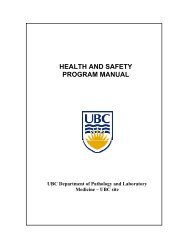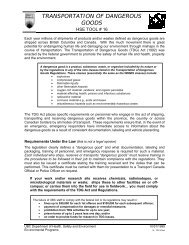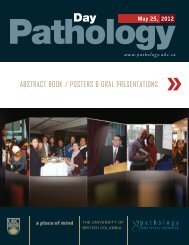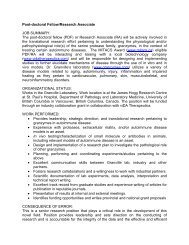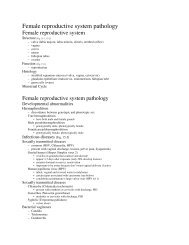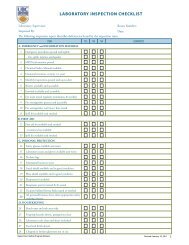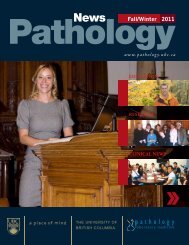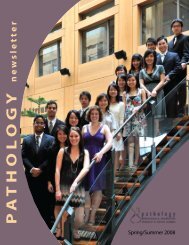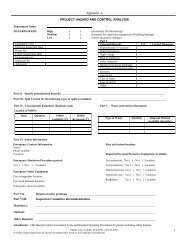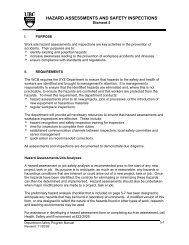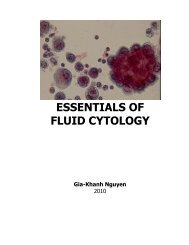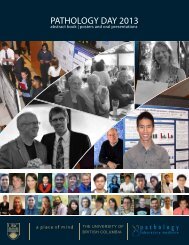OtherAbstract # 25Crystal Leung, Lise Matzke, Mike Allard, Bruce McManusJames Hogg Research Centre, Providence Heart + Lung Institute, St. Paul’s Hospital<strong>and</strong> Department of <strong>Pathology</strong> <strong>and</strong> <strong>Laboratory</strong> <strong>Medicine</strong>, <strong>University</strong> of British Columbia,Vancouver, BC, CanadaCrystal Leungharvesting value from human tissues at the timeof cardiac transplantation: one story from thecardiovascular biobankBackround/ObjectivesThe Cardiovascular (CV) Biobank was first established by Dr. McManus in 1982 at the <strong>University</strong> of NebraskaMedical Centre <strong>and</strong> was merged with the Pulmonary Biobank in the UBC Pulmonary Research <strong>Laboratory</strong> in1993. The CV Biobank triages <strong>and</strong> archives a wide spectrum of human cardiovascular specimens, includingnative <strong>and</strong> prosthetic heart valves, blood vessels, medical devices, endomyocardial biopsies, <strong>and</strong> hearts removed atthe time of transplantation or autopsy. This unique collection of biospecimens serves as a valuable resource fordiagnostic, educational, <strong>and</strong> investigative purposes. Of materials in the Biobank, the heart specimens from cardiactransplantation procedures have been widely used in many collaborative research studies <strong>and</strong> educational endeavours.The CV Biobank has developed a st<strong>and</strong>ardized method for effectively archiving <strong>and</strong> biobanking heart specimens fromcardiac transplantation, while preserving integrity to enable subsequent pathologic diagnosis.MethodsPatients awaiting cardiac transplantation are consented for inclusion into the CV Biobank heart archive (PHC ethicsH05-50208). Following removal of the heart during transplantation, the heart is picked up in heart collection(Hepes) buffer chilled on ice <strong>and</strong> brought back to the CV Biobank for archive. Gross images of each heart specimenare taken for documentation before the archiving process begins. The heart is given a Biobank ID - all tissues archivedfrom this heart are identified by this number thus protecting patient privacy. Selected, st<strong>and</strong>ardized tissue samples,including myocardium, aortic <strong>and</strong> mitral valves, coronary arteries, <strong>and</strong> aortic <strong>and</strong> pulmonary arteries are archived,preserved with formalin fixation, OCT embedding, flash freezing, <strong>and</strong> RNA-later submersion. In addition to thesepreservation steps, aortic <strong>and</strong> mitral valve sections are prepared <strong>and</strong> processed for cell culture; these are stored in liquidnitrogen. Upon completion of the archival process, formalin fixed samples are submitted to the James Hogg ResearchCentre (JHRC) Histology <strong>Laboratory</strong> for processing <strong>and</strong> paraffin embedding. The OCT-embedded, flash frozen, <strong>and</strong>RNA-later specimens are organized, stored, <strong>and</strong> catalogued at -80°C. The remainder of the heart is placed in formalin<strong>and</strong> later examined for diagnostic purposes. .Results <strong>and</strong> ConclusionsFrom 1996 to date, the CV Biobank has archived 218 explanted hearts from transplant recipients. This largecollection of heart specimens has been integral to studies of protein constituents in cardiomyopathies, genetics ofaortic valve stenosis, Biomarkers in Transplantation (BiT), <strong>and</strong> immunohistochemical character of failing hearts. TheCV Biobank is a cornerstone of the James Hogg Research Centre as an important resource to foster elucidation of themechanisms of disease <strong>and</strong> to accelerate health research with the intent of improving disease prevention, diagnosis,<strong>and</strong> treatment.36 2 0 1 0 * P o s t e r P r e s e n t a t i o n s
OtherCrystal Leung, Amrit Samra, Lise Matzke, Mike AllardJames Hogg Research Centre, Providence Heart + Lung Institute, St. Paul’s Hospital<strong>and</strong> Department of <strong>Pathology</strong> <strong>and</strong> <strong>Laboratory</strong> <strong>Medicine</strong>, <strong>University</strong> of British Columbia,Vancouver, BC, CanadaAbstract # 26methodological issues related to pathologicalevaluation of coronary artery stentsCrystal LeungBackround/ObjectivesIntravascular placement of metallic stents is currently a common means of treatment for stenosed coronary arteries.Coronary stents are, however, associated with risk of in-stent restenosis <strong>and</strong> late-stent thrombosis which may lead torepeated target vessel revascularization or other life threatening conditions such as myocardial infarction or death.Pathological evaluation of stented coronary arteries is needed to document these complications <strong>and</strong> to characterizestent-tissue interactions in order to improve safety <strong>and</strong> efficacy of coronary stents. Thus, high quality tissue sections arerequired with excellent preservation of the morphology of stented artery, particularly at the stent-tissue interface.MethodsThirteen stented coronary artery segments from six cases of cardiac transplantation <strong>and</strong> seven routine autopsies,fixed in 10% neutral buffered formalin, were used. These specimens were dehydrated in an increasing graded seriesof isopropanol. In a vacuum chamber, the specimens were immersed in infiltration solution (benzoylperoxide withhydroxyethyl methacrylate) from the JB-4 Plus Embedding Kit® (Polysciences, Inc.). The specimens were thentransferred into the embedding medium (infiltration solution with polyethylene glycol) <strong>and</strong> let polymerized underanaerobic conditions. After the medium has hardened, the specimens were cut into 5mm thick plastic blocks witha high-speed rotary saw. The plastic blocks were then affixed to the specimen holder using the embedding medium<strong>and</strong> sectioned with a JB-4 microtome (Sorvall®). The sections were subjected to hematoxylin <strong>and</strong> eosin staining <strong>and</strong>photomicroscopy was performed using the Nikon® CoolScope Digital Microscope.ResultsAfter successful processing, embedding, <strong>and</strong> staining, morphology of all 13 coronary artery segments, including thestent-tissue interface, was preserved <strong>and</strong> readily visible. To achieve adequate staining intensity, the sections of thestented arteries required prolonged hematoxylin staining. Some stents were displaced from their original implantedposition during sectioning <strong>and</strong> staining. Attempts to use another plastic embedding medium (Technovit 9100 methylmethacrylate) have been unsuccessful so far. This is primarily related to failure of the block to adhere to the holderduring sectioning.ConclusionsUsing the glycol methacrylate embedding technique, the morphology of the stent-tissue interface of stented arteriescan be readily observed by microscopy. Failure to maintain the stent in its original position is an importantlimitation, possibly related to the relative softness of the medium. Refining the methodology may lead to a moreefficient protocol <strong>and</strong> enable more specialized staining <strong>and</strong> immunohistochemistry as well as the use of harder plasticmedia such as methyl methcrylate.Poster <strong>Presentations</strong> * 2 0 1 037
- Page 2: PathDay: Keynote Speaker (4:30 pm)T
- Page 5: Conference Outline2010abstract #14
- Page 9 and 10: Table of Contentabstract #57 The ro
- Page 11 and 12: ResidentClinical SciencesArwa Al-Ri
- Page 13 and 14: ResidentTitus Wong 1 , Marc Romney,
- Page 17 and 18: ResidentD. Turbin 1 , D. Gao 2 , J.
- Page 19 and 20: ResidentDavid F Schaeffer 1 , Eric
- Page 21 and 22: ResidentMajid Zolein 1 , Daniel T.
- Page 23 and 24: Graduate StudentAshish K. Marwaha 1
- Page 25 and 26: Graduate StudentAmanda Vanden Hoek
- Page 27 and 28: Graduate StudentXin Ye 1 , Mary Zha
- Page 29: Graduate StudentLisa S. Ang 1 , Sar
- Page 32 and 33: Graduate StudentAbstract # 22Brian
- Page 38 and 39: OtherAbstract # 27Lise Matzke 1 , W
- Page 40 and 41: Graduate StudentAbstract # 29Varun
- Page 42 and 43: Graduate StudentAbstract # 31Maite
- Page 44 and 45: Post-doctoral FellowAbstract # 33Ra
- Page 46 and 47: Graduate StudentAbstract # 35Hayley
- Page 48: Post-doctoral FellowAbstract # 37Es
- Page 51 and 52: ResidentAhmad Al-Sarraf MD 1, 2 , G
- Page 53 and 54: OtherRebecca Towle 1 , Danielle Mac
- Page 55 and 56: Graduate StudentPaul R. Hiebert 1,2
- Page 57 and 58: Graduate StudentV. Montoya 1 , J. G
- Page 59 and 60: OtherWalter Martz and Henry Kalicia
- Page 61 and 62: OtherKatelyn J. Janzen 1 , Elizabet
- Page 63 and 64: Graduate StudentJasmine L. Hamilton
- Page 65 and 66: Graduate StudentIan M. Wilson 1 , K
- Page 67 and 68: Graduate StudentKelsie L. Thu 1,3 ,
- Page 69 and 70: OtherLiat Apel-Sarid 1 , Doug Cochr
- Page 71 and 72: Graduate StudentJennifer R. Choo 1,
- Page 73 and 74: Graduate StudentEdwin S. Gershom 1
- Page 75 and 76: OtherYing Qiao 1, 2 , Chansonette H
- Page 77 and 78: Graduate StudentLeslie YM Chin 1,4
- Page 79 and 80: Graduate StudentBillie Velapatiño
- Page 81 and 82: Graduate StudentSophie Stukas 1 , S
- Page 83 and 84: Graduate StudentKyluik DL and Scott
- Page 85 and 86:
Post-doctoral FellowJoel Montane 1
- Page 87 and 88:
IndexAAbozina A. 45Abraham T. 55All
- Page 89:
Ye X. 27, 82Yee S. 31Yoshida E. 12Y



